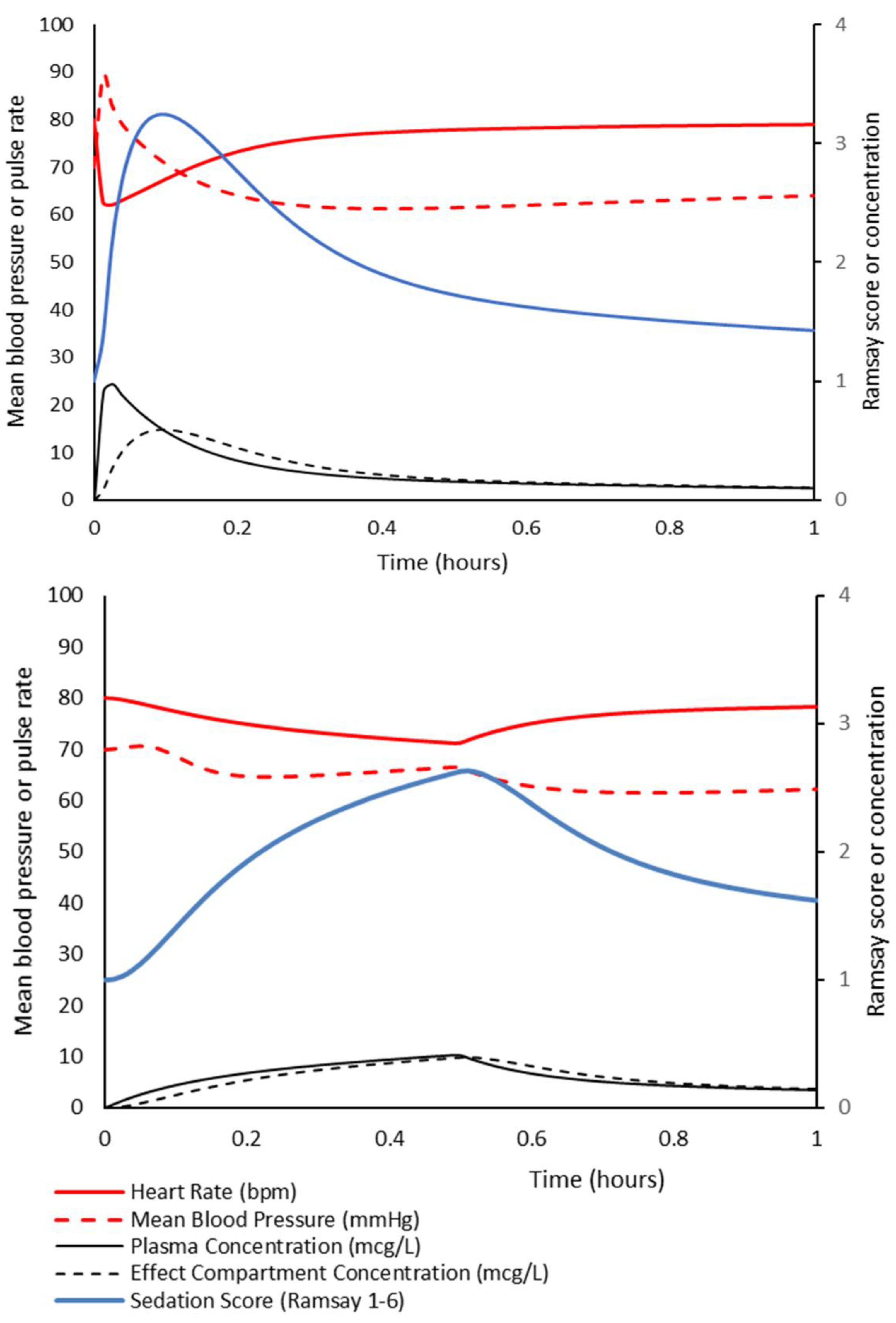Estimation of the Loading Dose for Target-Controlled Infusion of Dexmedetomidine. Reply to Eleveld et al. Comment on “Morse et al. A Universal Pharmacokinetic Model for Dexmedetomidine in Children and Adults. J. Clin. Med. 2020, 9, 3480”
Author Contributions
Funding
Conflicts of Interest
References
- Morse, J.D.; Cortinez, L.I.; Anderson, B.J. A universal pharmacokinetic model for dexmedetomidine in children and adults. J. Clin. Med. 2020, 9, 3480. [Google Scholar] [CrossRef] [PubMed]
- Hannivoort, L.N.; Eleveld, D.J.; Proost, J.H.; Reyntjens, K.M.; Absalom, A.R.; Vereecke, H.E.; Struys, M.M. Development of an optimized pharmacokinetic model of dexmedetomidine using target-controlled infusion in healthy volunteers. Anesthesiology 2015, 123, 357–367. [Google Scholar] [CrossRef] [PubMed]
- Wada, D.R.; Drover, D.R.; Lemmens, H.J. Determination of the distribution volume that can be used to calculate the intravenous loading dose. Clin. Pharm. 1998, 35, 1–7. [Google Scholar] [CrossRef] [PubMed]
- Potts, A.L.; Anderson, B.J.; Holford, N.H.; Vu, T.C.; Warman, G.R. Dexmedetomidine hemodynamics in children after cardiac surgery. Paediatr. Anaesth. 2010, 20, 425–433. [Google Scholar] [CrossRef]
- Perez-Guille, M.G.; Toledo-Lopez, A.; Rivera-Espinosa, L.; Alemon-Medina, R.; Murata, C.; Lares-Asseff, I.; Chavez-Pacheco, J.L.; Gomez-Garduno, J.; Zamora Gutierrez, A.L.; Orozco-Galicia, C.; et al. Population pharmacokinetics and pharmacodynamics of dexmedetomidine in children undergoing ambulatory surgery. Anesth. Analg. 2018, 127, 716–723. [Google Scholar] [CrossRef] [PubMed]
- Li, A.; Yuen, V.M.; Goulay-Dufay, S.; Sheng, Y.; Standing, J.F.; Kwok, P.C.L.; Leung, M.K.M.; Leung, A.S.; Wong, I.C.K.; Irwin, M.G. Pharmacokinetic and pharmacodynamic study of intranasal and intravenous dexmedetomidine. Br. J. Anaesth. 2018, 120, 960–968. [Google Scholar] [CrossRef] [PubMed] [Green Version]
- Morse, J.; Hannam, J.A.; Cortinez, L.I.; Allegaert, K.; Anderson, B.J. A manual propofol infusion regimen for neonates and infants. Paediatr. Anaesth. 2019, 29, 907–914. [Google Scholar] [CrossRef] [PubMed]

Publisher’s Note: MDPI stays neutral with regard to jurisdictional claims in published maps and institutional affiliations. |
© 2021 by the authors. Licensee MDPI, Basel, Switzerland. This article is an open access article distributed under the terms and conditions of the Creative Commons Attribution (CC BY) license (https://creativecommons.org/licenses/by/4.0/).
Share and Cite
Morse, J.D.; Cortinez, L.I.; Anderson, B.J. Estimation of the Loading Dose for Target-Controlled Infusion of Dexmedetomidine. Reply to Eleveld et al. Comment on “Morse et al. A Universal Pharmacokinetic Model for Dexmedetomidine in Children and Adults. J. Clin. Med. 2020, 9, 3480”. J. Clin. Med. 2021, 10, 3004. https://doi.org/10.3390/jcm10143004
Morse JD, Cortinez LI, Anderson BJ. Estimation of the Loading Dose for Target-Controlled Infusion of Dexmedetomidine. Reply to Eleveld et al. Comment on “Morse et al. A Universal Pharmacokinetic Model for Dexmedetomidine in Children and Adults. J. Clin. Med. 2020, 9, 3480”. Journal of Clinical Medicine. 2021; 10(14):3004. https://doi.org/10.3390/jcm10143004
Chicago/Turabian StyleMorse, James D., L. Ignacio Cortinez, and Brian J. Anderson. 2021. "Estimation of the Loading Dose for Target-Controlled Infusion of Dexmedetomidine. Reply to Eleveld et al. Comment on “Morse et al. A Universal Pharmacokinetic Model for Dexmedetomidine in Children and Adults. J. Clin. Med. 2020, 9, 3480”" Journal of Clinical Medicine 10, no. 14: 3004. https://doi.org/10.3390/jcm10143004
APA StyleMorse, J. D., Cortinez, L. I., & Anderson, B. J. (2021). Estimation of the Loading Dose for Target-Controlled Infusion of Dexmedetomidine. Reply to Eleveld et al. Comment on “Morse et al. A Universal Pharmacokinetic Model for Dexmedetomidine in Children and Adults. J. Clin. Med. 2020, 9, 3480”. Journal of Clinical Medicine, 10(14), 3004. https://doi.org/10.3390/jcm10143004





